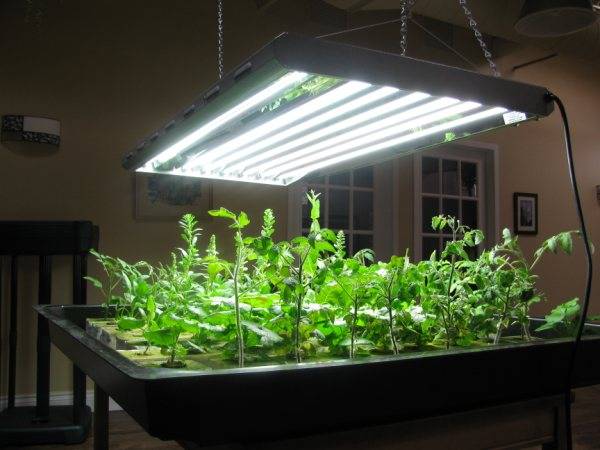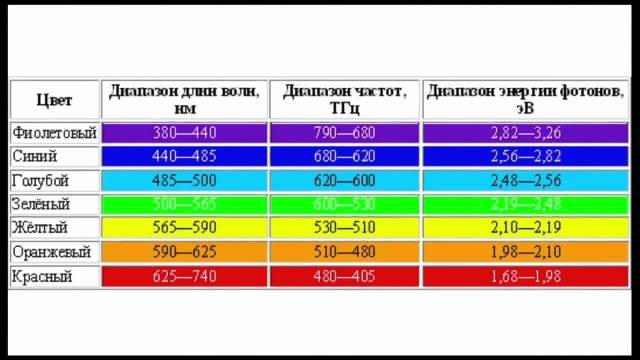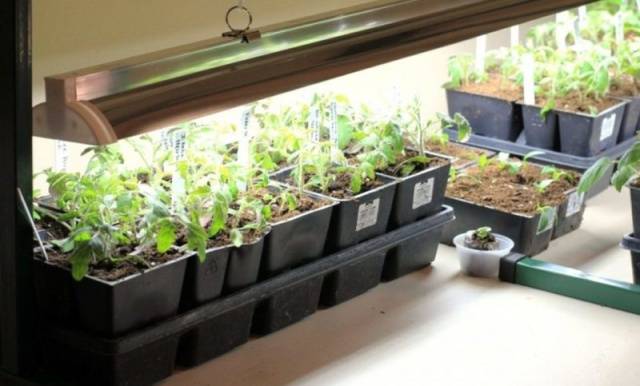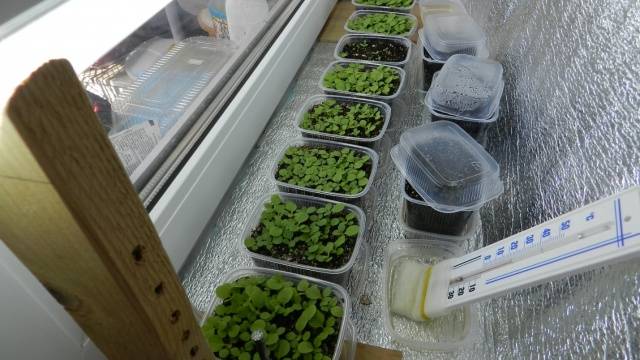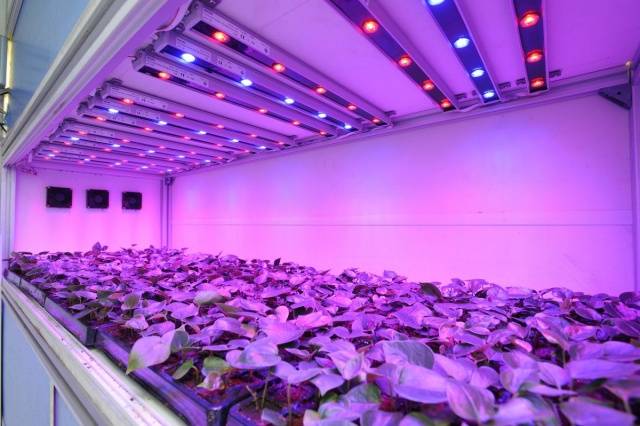Content
Lack of sunlight is bad for the development of seedlings. Without artificial supplementary lighting, the plants stretch towards the window glass. The stem becomes thin and curved. Strong darkening creates favorable conditions for the development of pathogenic bacteria. The plantings are affected by the "black leg". To create optimal conditions for development will help light for seedlings from lamps.
The need for additional lighting
Even when growing planting material in a bright room, additional lighting for seedlings is still required. Sowing seeds in many regions begins in February. Daylight hours are still short at this time of the year. In plants, starvation begins due to a lack of natural light. With the onset of dusk, the production of photosynthesis decreases. To remedy the situation, vegetable growers organize supplementary lighting of seedlings at home with their own hands, thereby extending the daylight hours.
The benefits of artificial lighting are undeniable:
- increase in daylight hours if necessary early forcing of seedlings;
- uniform illumination of the entire area prevents stretching and bending of plant stems;
- a well-chosen light spectrum contributes to the rapid development of cells;
- seedlings that have received the required amount of light become more resilient to bad weather conditions and infection by viruses.
Knowing about the benefits of additional lighting, vegetable growers prepare in advance lamps for growing seedlings at home, but they are faced with a new problem. Not all artificial light is good for plants. Conventional incandescent bulbs will not be useful. The emitted light spectrum is not absorbed by plants. Artificial lighting will be beneficial if it contains red and blue rays.
The red glow is useful for seeds at the initial stage of hatching. Spectrum accelerates root growth. In the future, this will affect a good ovary and quick ripening of fruits.
The blue glow promotes cell division and development. Rapid growth slows down. The stem does not stretch, but grows in thickness.
Green, orange and yellow rays reflect off the foliage. These spectra do not play a special role in the development of plants, but they must be present in artificial lighting.
Additional lighting options
When choosing a lamp for lighting seedlings at home, they pay attention to two important parameters: low power consumption and emission of spectra useful for the plant. From the light sources on the market, you can choose the following options:
- Conventional incandescent lamps will not bring benefits to seedlings due to the lack of blue and red spectrum radiation. They consume a lot of electricity. However, the lamp emits a lot of heat. It can be paired with another light source if the room is cool and the air around the seedlings needs to be heated.
- The best option is to illuminate the seedlings with fluorescent lamps, which are only inferior to LEDs in terms of performance. Here, the first place is the cheapness of the product. However, the lamps are low-power, and it is advisable to hang them over the seedlings in two pieces.
- Luminescent housekeepers for chandeliers similarly emit white daylight. However, the lamps cover a small area.It is better to give preference to tubular models.
- Sodium lamps have a high luminous efficiency. The bright yellow light is harmful to eyesight and not particularly beneficial to seedlings. Lamps are suitable as a temporary light source and preferably in a non-living room.
- LEDs emit the entire spectrum useful for seedlings. Lamps, lamps are used for illumination, but the most convenient are considered led strip and rulers. It is convenient to place them along the entire length shelves shelving with seedlings. LEDs are economical, do not emit heat, and are characterized by a long service life.
- If you are serious about growing seedlings, then it is better to purchase a phytolamp for illumination. The device consists of a set of red and blue LEDs. Light bulbs of other colors may be added in small quantities. LED phytotopes are on sale. Lighting will come out a little expensive, but it will pay off over time.
The number and power of the lamps are selected, taking into account the area required to illuminate.
Arrangement of lighting and places for convenient growing of seedlings
The traditional place for growing seedlings is the windowsill. However, there is not enough space for the boxes, and there is still not enough daylight from the window. It will be possible to expand the space and equip the lighting for seedlings at home by resorting to tricks:
- You can expand the space for seedlings by making a rack. A structure of three shelves is placed on the windowsill. If this is not enough, a stationary rack of five shelves is assembled and placed on the floor. It is optimal to choose a place opposite the window, so that during the day the plants receive additional natural light. Racks are assembled from improvised material: wooden slats, a steel corner or profile, a PVC sewer pipe with a diameter of 50 mm. The shelves are cut from durable sheet material.
- A gazebo can be adapted for growing seedlings. Open openings are covered with transparent film. The plants in the greenhouse gazebo will be light, but in the evening you still need to turn on artificial lighting. A cheap fan heater is suitable for heating the room.
- To make it work illumination for seedlings with their own hands minimum cost, a homemade holder is made for lamps. The design consists of two U-shaped supports with height-adjustable legs and a jumper to which the light source is fixed. The holder is more suitable for installation on a windowsill.
- If there is any protruding support in the form of a hook, window hinge or handle above the seedlings, a pendant lamp is attached to it. The option is suitable when the seedlings are illuminated at home on shelves. If the luminaire is not adapted for suspension, two ends of the chain are fixed to its body. The suspension is made adjustable so that you can change the height of the lamp above the seedlings.
- Simple seedling lamp do it yourself from blue and red LEDs. The bulbs, together with the separating resistors, are soldered with wires into one circuit, fixed on the bar and connected to the power supply. An easier option is to buy an LED strip with an aluminum profile and assemble a lamp from them.
- If additional illumination of small amounts of seedlings is required, use a portable shelf. A factory-made floor lamp is suitable or a structure with a height of 1.5 m is assembled from slats.
A properly organized place and lighting should ensure the comfort of the seedlings, without creating inconvenience to the person.
The benefits of combining natural and artificial light
The beauty of natural light is that its rays are scattered over the plants for better absorption. Any artificial light source emits long, directional beams. If it is not possible to place the seedlings close to the window, you will have to upgrade the lighting. Regardless of the type of lamp used, the luminaire is equipped with a matt light diffuser.Shorter beams will cause less injury to plants.
In a room brightly lit by daylight with large windows, it is advisable to move the seedlings to the windowsill. If it is small, make a rack with three shelves. The combination of natural and artificial lighting will not only save energy, but also have a beneficial effect on the development of plants.
The light falling from the window brightly illuminates only close-growing plantations, and distant plants fall into the shade. If you do not turn the boxes, the stems begin to stretch towards the window. There are tricks out there to direct and even enhance natural light. The secret is based on the use of mirror reflectors. Foil, old mirrors or foil insulation - foamed polyethylene are suitable for manufacturing.
The bottom line is that the window sill is covered with reflective light material, shields are installed on the sides of the window opening and opposite the window behind the boxes with seedlings. It turns out a kind of mirror room, inside which the plants are located. The set falling from the window does not spread throughout the room, but is reflected from the mirror shields, evenly scattering throughout the seedlings. With the onset of dusk, artificial lighting is turned on.
Assembling the LED lamp
It is reasonable to assemble a homemade LED lamp if unnecessary Christmas tree garlands or pieces of red and blue LED strips are lying around at home. Specially buying all the parts is more expensive than buying a ready-made phytolamp. To obtain the optimal combination of spectra, the ratio of LEDs is adhered to in a homemade lamp: 1 blue lamp contains 2–5 red lamps.
If the houses are littered with LED garlands, then the lamp for additional illumination of seedlings is soldered from separate bulbs. Any rail or plinth is taken as the basis of the lamp. From a non-working garland, the LEDs are cut off along with the isolation resistors. Using a multimeter, they check the performance of the parts, and also find out the polarity. Working LEDs are soldered in parallel with a wire in one chain. If the lamps light up when connected to a DC power supply, the circuit is assembled correctly. It remains to fix the luminous chain on the bar with scotch tape or hot glue.
The assembly of the luminaire from pieces of LED strips occurs in a similar sequence. On a strip basis, there are modules consisting of three blocking resistors and diodes. To alternate red and blue bulbs, you will have to cut the tapes into modules, and then solder them. It is easier to fix two LED strips of different luminescence on the base in parallel. It will not be possible to pick up the correct ratio of light bulbs, but this will not do much harm to the seedlings.
The video shows a homemade LED lamp:
When arranging lighting for seedlings with your own hands, you need to take into account the brightness of the lamps and the distance from the seedlings. Plants are sensitive to light in different ways. Some are comfortable with bright lighting, while others are comfortable with moderate light. The brightness of the backlight is adjusted with a dimmer. The regulator is placed in a circuit in front of the lamps. Illumination is regulated by the height of the lamp. The gap between the light source and the plants is kept in the range of 10–50 cm. If the lighting is done correctly, at the time of planting the grower will receive strong seedlings.
